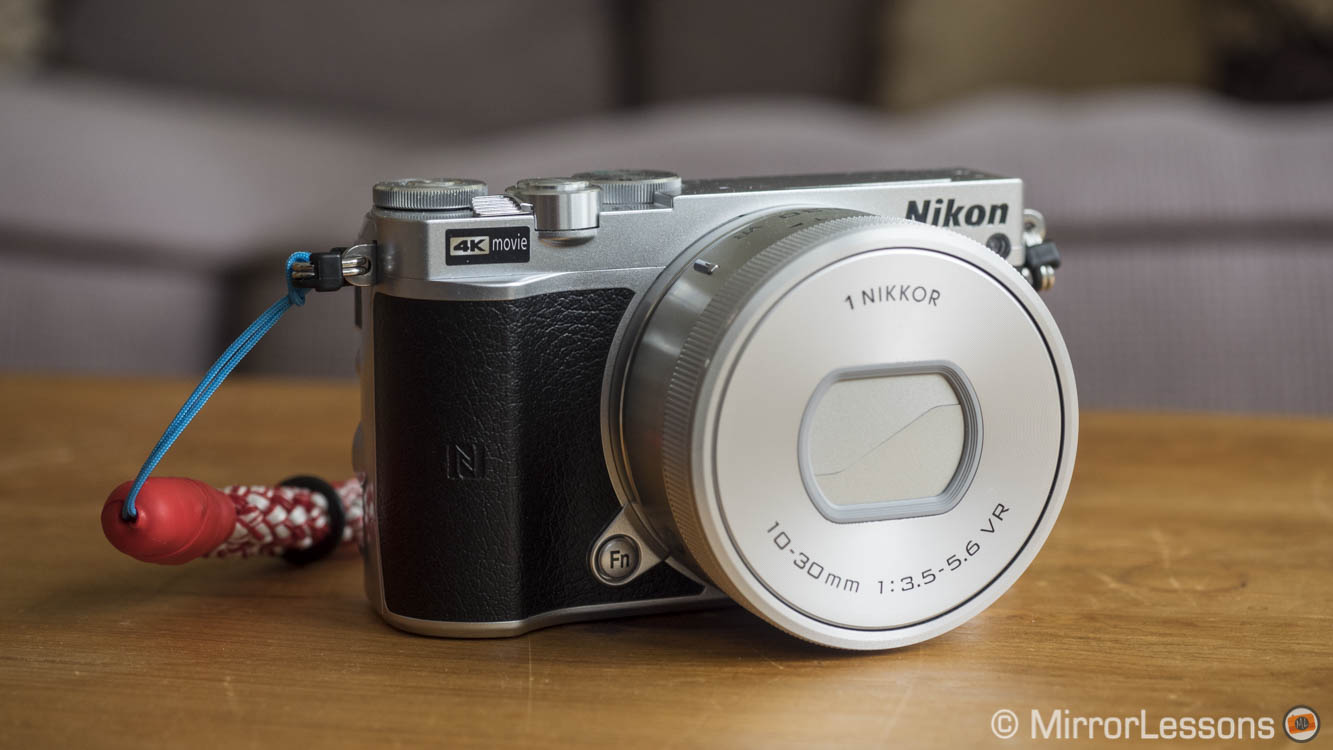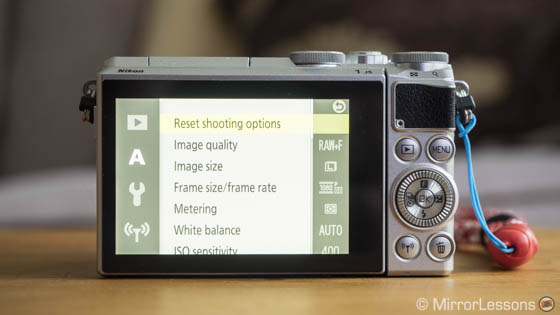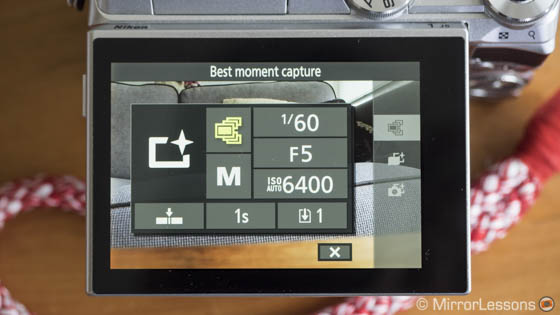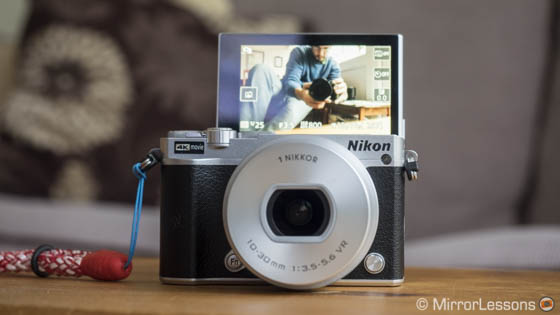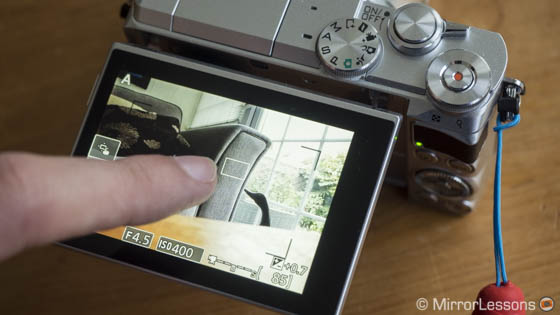The Nikon 1 system is often underrated because of its small 1-inch CX sensor but it offers both stunning autofocus performance and continuous shooting speeds. The problem is that the series didn’t get off on the right foot. The first models were too expensive and I’ve always felt that there was a large discrepancy between the amazing performance and the target user. Expert photographers generally don’t consider the system because of the small sensor, while shooting at 30 or 60fps is probably too much for an amateur’s needs.
The fact that Nikon released so many cameras with similar specs in such a short span of time led to confusion and eventually a lack of interest. For example, the entry-level Nikon 1 S1 felt quite cheap with its plasticky build and lack of controls but it was introduced at the initial retail price of $500, which was close to the offerings of other brands with larger sensors. The most interesting model in the series is the Nikon 1 AW1 for its underwater capabilities with specific lenses. The camera is a modern digital version of the famous Nikonos, an old 35mm film camera.
Nikon recently updated its strategy and decided to concentrate on the J series while assigning the role of flagship model to the Nikon 1 V3. While the price is still a little high in my opinion, the cameras have received noteworthy improvements in almost every department. The Nikon 1 J5 is the latest addition in the line-up. Thanks to a re-styling, it finally looks and feels right and packs all the most recent 1 series technology.
Is it the best Nikon 1 camera yet? Let’s find out!



Nikon 1 J5 Main Specs
- Sensor: 20 megapixel CX CMOS
- Lens system: 1 mount
- Weatherproof: None
- Internal Stabilisation: None (VR on selected lenses)
- Autofocus: Hybrid AF with 66 contrast and 105 phase detection areas
- Continuous shooting: 60 fps (AF-S), 20 fps (AF-C)
- ISO Sensitivity: 160 – 12800 ISO
- Shutter Speeds: 1/16000s (electronic) to 30 seconds
- Viewfinder: None
- LCD Screen: 180° tilting 3″ LCD monitor (1037k dots)
- Movie recording: 4K at 15fps, Full HD up to 60fps
- Built-in Flash: Yes
- Extra Features: WiFi, NFC, Advanced Movie Mode, Motion Snapshot, Best moment capture
- Dimensions: 98.3 x 59.7 x 31.5mm
- Weight: 231g
[toc heading_levels=”3″]
Design, ergonomics and ease of use
The Nikon 1 J5 features a brand new design. There aren’t any flashy colours anymore but rather a choice of white, silver or black. It has a good build quality with a plastic finish and metal dials on top. It doesn’t feel cheap like the earlier models. The tilting LCD screen is robust, as are the HDMI/USB/Battery ports. All the buttons feel solid and are easy to access. For such a small and lightweight body, I don’t think Nikon could do better. Only the built-in pop-up flash feels more delicate.
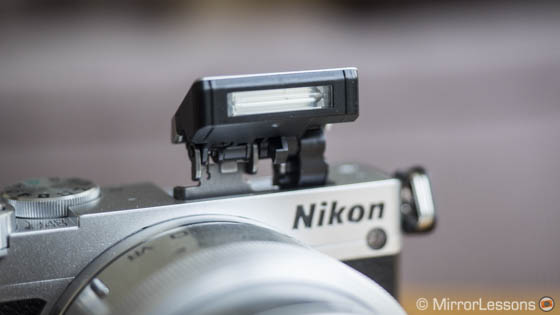
The J5 has also been improved in terms of the ergonomics and ease of use.
First we get a built-in grip on the front and a thumb rest on the rear that significantly improve your grip on the camera. It is still not perfect especially for someone like me who has big hands but you might read this comment of mine in many of our camera reviews!
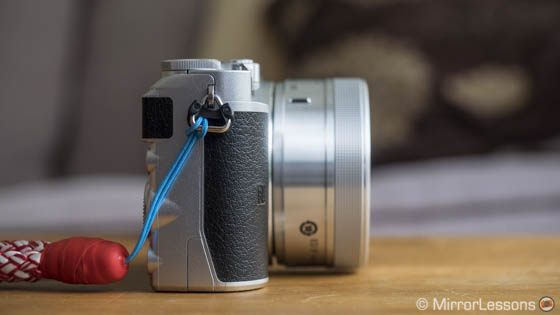
On top we get a second dial to control the exposure in addition to the shooting mode dial. There is also a Fn button on the front of the camera that I initially confused with the lens mount release which is on the right. The Fn button can be customised with 7 settings that are mostly basic such as ISO, White Balance, Metering or AF Area. It would be helpful to be able to configure extra buttons like the Wifi or Rec buttons.
On the rear, the F (Features) button on top of the command wheel activates a quick menu with all the most important settings depending on the shooting mode selected. That is what I used most of the time. Also the main menu of the camera is context-sensitive. It only shows you the settings relevant to the shooting mode selected. This makes navigation quick and easy.
The LCD screen is touch sensitive and you can use it for almost every operation from changing the aperture to navigate inside the menu. It recognises gestures such slides or pinches to playback or zoom in/out on an image. Of course you can use it to focus or take a shot just by touching it. Overall it is a handy feature to have but I did notice some lack in precision when selecting a focus point or navigating inside the menu. The screen can be tilted down 45° and up 180°. This activates a selfie mode with face detection and the option of a self timer.
The only negative point about this camera is that it doesn’t give you a real preview of your exposure in the most advanced modes.
Instead it always shows you an optimal brightness so you can only rely on the metering. You only get real time exposure with some auto/beginners modes. Another thing is that the camera uses Micro SD cards which are really small.
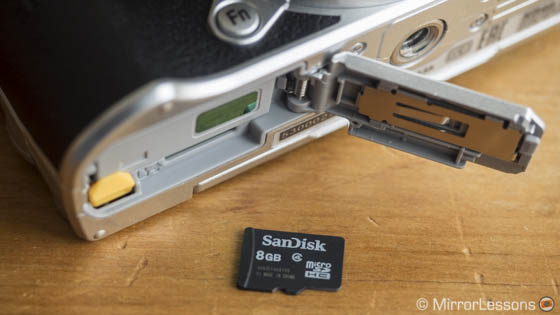
Image Quality
The Nikon 1 J5 features a 20MP sensor and is currently the 1 camera with the highest resolution. The ISO sensitivity goes from 160 to 12800. Overall I found its performance similar to the Sony RX100 series which is in my opinion very good for this type of sensor.
At low ISOs, the camera gives you a balanced image with good sharpness and detail rendering. Of course this also depends on the lens used. The 10-30mm f/3.5-5.6 kit lens is decent but lacks some sharpness especially when focusing close. Nikon’s colour profiles look natural with good contrast and a slightly warm rendering that is typical of Nikon cameras.


Click on the image to open the full res version.

Click on the image to open the full res version.

Click on the image to open the full res version.

Click on the image to open the full res version.
Choosing the right picture profile can be important especially if you want to work with the OOC JPGs. The most saturated colour profiles such as vivid for example seem produce weak reds. In the example below you can see how I retained more detail in the roses by choosing the neutral profile instead of the vivid profile. The same happens if you apply the camera’s profile in Lightroom.
- Slide to the right to see the Neutral version
- Slide to the left to see the Vivid version.
[twentytwenty]


[/twentytwenty]
The camera has three metering modes and the Multi one (Matrix) is very accurate overall. Only a few times did it tend to underexpose.
The dynamic range is fine and provides a good level of detail in both shadows and highlights. However the ability to recover information from the Raw files is more limited.

Below is an example of an attempted recovery from the original shot. It shows the limit of the Raw files in terms of highlight recovery: -1/2 Ev, -50 highlights and +20 of shadows and contrast with Lightroom. Any more than that would have made white clipping too visible.
- Slide to the right to see the original version
- Slide to the left to see the processed version.
[twentytwenty]


[/twentytwenty]
Below is another example that focuses on shadow recovery: +2Ev, -20 highlights, +50 shadows and +10 contrast. If you open the full resolution image, you might notice some green colour shift in the bottom right corner.

Click on the image to open the full res version.
For the JPG output, the camera has a D-Lighting option that extends the dynamic range. Beware that it can create bright halos around the edges of your subject. You can see an example below around the motocross biker. It is a shame because otherwise it does a good job of balancing the shadows.

The best thing if you need more dynamic range is to use HDR. Now unfortunately the HDR option within the camera is limited to JPG only (2 shots). It doesn’t have proper AE or HDR bracketing for Raw files. I took some HDR by manually changing the exposure. It takes more time but definitely helps to have a wider dynamic range.
Not having AE/HDR bracketing is a shame because with the shooting speed capabilities the J5 possesses, you could take 5 or 7 shots in 0.1s.


In low light, the camera performs well and I found 3200 ISO usable. It retains a good level of detail and noise isn’t too invasive. At 6400 ISO you start to see some colour shift in the shadows and more invasive noise. Here again the camera more or less matches the performance of the Sony RX100 series. It is important to leave Noise Reduction to off with the JPGs because it is quite aggressive.

Click on the image to open the full res version.

Click on the image to open the full res version.

Click on the image to open the full res version.

Click on the image to open the full res version.
Autofocus and performance
If there is one aspect to praise about the Nikon 1 series, it is the autofocus.
The first generation cameras were already fast but since the implementation of phase detection points (starting with the V3), the system has became one of the most accurate and consistent in terms of performance.
The Nikon 1 J5 has 171 phase detection points and 105 of them are phase detection. The camera can lock focus really quickly and I didn’t have any problem in low light conditions either. You can choose the single AF point or Multi where the camera automatically chooses the number of areas. The latter is very accurate and was helpful for fast moving subjects like birds. There is also a Subject Tracking option that works fine but I didn’t find it necessary to use it most of the time.
Note: the soft results in the bird picture below is the fault of the lens (1 Nikkor 70-300mm). It lacks some sharpness at the telephoto end for distant subjects.


The J5 has three focus modes: AF-S, AFA and AF-C. The second will automatically switch between Single and Continuous depending on whether you subject is static or moving. The latter is of course the best choice for action and sports and this is where the J5 starts really to excel. The camera never fails to nail focus precisely even when following a fast subject or where the focus distance changes a lot. In the example below, you can see how well the J5 tracked the approaching biker with the 1 Nikkor 70-300mm (click on the image to open the burst sequence).
Note: you can also check out my dedicated post about the AF performance of the camera here.
The J5 has lots of different options for continuous shooting. On the main dial there is a dedicated Sports mode where the camera automatically selects the appropriate settings. It is a nice option for beginners. More expert photographers will appreciate the possibility to select different speeds depending on their needs:
- Continuous shooting: the camera works at 5fps and lasts for a longer period of time
- 10fps and 20fps: works in focus priority but the maximum number of shots that can be taken in a row is limited to 20.
- 30fps and 60fps: focus is locked on the first frame and there is the same 20 shot limit.
The speed at 60fps is impressive as you can see in the short animation above. However since the camera will stop at the 20th image, you have to be sure to time it right because the burst will last 1/3 of a second. This limitation could seem strange at first but I actually think it was a good choice. When I tested the V2 two years ago, shooting at 60fps meant that I filled up my SD card with too many pictures and making the selection at home was a nightmare. Not even professional photographers shooting the World Cup need that kind of speed. Note that starting from 15fps, the camera uses the electronic shutter.
The buffer capabilities of the camera are good. I used a pretty basic Micro SD card so the writing speed wasn’t the best but with a faster card, the performance should be excellent. Of course, I advise you to shoot in JPG only. The burst shots are organised in different groups when you review them in playback mode and that helps to review all the different shots you took.
The Nikon 1 series also introduced different “Smart” functions to allow beginners to take advantage of the stunning speed of the camera. If you turn the mode dial to Best Moment Capture, you can select the following options:
- Active selection: takes a very fast burst, then lets you select the picture you prefer in playback mode (you can save only one image).
- Slow view: same thing but the pictures taken play in a slideshow until you pick your favorite.
- Smart photo selector: the camera automatically chooses the best shot for you.
I admit I didn’t use these modes but my favourite is definitely the Slow view. Once you get used to it, it can become a quick way of selecting the best pictures before you even load them onto your computer.
Video
The J5 is the first Nikon 1 camera to have 4K capabilities but unfortunately it can only shoot at 15fps. This means that your footage will lack some fluidity especially when dealing with movements. Honestly it feels more like an extra spec put there just to make it seem as if the camera is up-to-date with the market offering. I am sure that the next camera will have better 4K performance. The quality of the footage is not bad so I am sure that Nikon can do better.
The camera can also shoot in Full HD at 30 or 60fps for a maximum of 17 minutes per clip. There are no 25 or 50fps options for PAL users but the camera has flicker reduction to avoid banding. Manual exposure is available and you can use the touch screen to adjust focus while recording. You can also take a picture while recording a movie (HD only). The J5 also has a time-lapse movie option as well as fast motion (playback is 4 times faster), jump cut to do a live edited video, and 4s movie clip that you can edit in camera.
There is also the Motion Snapshot mode where the camera combines a short video with one still image. You can even have music in the background. However this is feature that has never been upgraded from the first 1 cameras and I found it quite limiting. It could have more options such as adding 2 or 3 different still pictures and movie clips. Nikon could also make the effort to provide more background music choice. You can see an example below of this function (taken with the V2).
The most interesting aspect is the slow motion feature.
It offers 120fps at 720p, 400fps and 1200fps at a lower resolution. The first is by far the best option to maintain acceptable quality and is also the only one to maintain a 16:9 aspect ratio while the other two options have a 8:3 aspect ratio. Nikon was among the first to introduce slow motion capabilities to their cameras but until now, the resolutions available were always below standard definition. The J5 upgrades the capabilities to 720p which is not bad but lags behind the recent Sony RX cameras (RX100 VI and RX10 II). Also the recording is limited to 3s per clip (12s of length at 30fps). Focus must be set before as the camera won’t track during recording.
Below you can see a slow motion video taken with the J5 at 120fps at the Barmouth Beach Race.
Other features
The Nikon 1 J5 doesn’t have built-in stabilisation except for a software version for movie recording. For stills it relies on the lens VR (Vibration Reduction) system. I did manage to get acceptable results down to 0.5s but I must say that overall I wasn’t impressed with the VR performance mainly because of the irregularity of the results. Often I had trouble getting a sharp shots even at 1/20s at 10mm.


On the main dial you can choose a Creative Mode to access different filters as well as the HDR and Panorama modes. The latter is not bad but doesn’t always do a good job of correctly stitching the images together as you can see below. The camera works in automatic mode with that feature and you might need one or two attempts to get acceptable results.


As mentioned before, the J5 has an electronic shutter option that allows to shoot up to 1/1600s and can also make the camera completely silent (just turn off the shutter noise in the sound sub-menu).
Finally we get Wifi and NFC capabilities and as usual you can connect the camera to your mobile device to transfer images or remotely control the camera. The App on iOS is very basic and you can’t access the exposure settings through the phone. The only thing you can adjust is the image brightness. You can’t record video either. When exiting the Wifi mode, it takes quite a long time for the camera to go back in the normal shooting mode (4-5s).
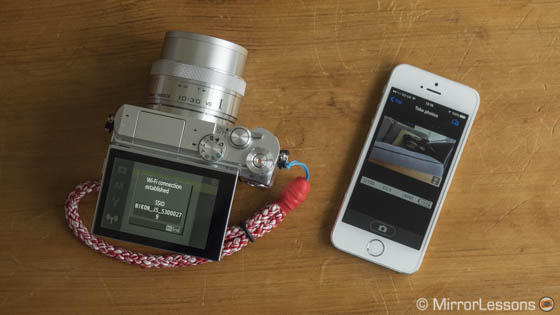
Finally, the battery life is not great.
If you shoot in continuous mode or take lots of video clips, it will run out in two hours or less. One day I went to a natural reserve to take some wildlife pictures with the 70-300mm. I shot at 5fps and C-AF without recording a single movie clip but after two hours and 125 pictures the battery had died. The only extra thing I did was take some shots at sunrise on the same day. The camera can’t be charged via USB which is another disappointment.
Conclusion
The J5 is a relevant update to the Nikon 1 series. It is the first J version that I’ve found more comfortable to use thanks to its new design and more complete interface. Its small size makes it portable and its stunning speed will impress even expert photographers. The sensor performance is good for a 1 inch type sensor, although more demanding photographers will find the lack of dynamic range and shallow depth of field a limitation because there aren’t a lot of fast lenses available for the system.
One problem that remains in my opinion is the price point. At around $500, there are a lot of interesting offerings from other brands with larger sensors and therefore better image quality. Personally I would consider the 1 system for certain uses with specific lenses like the Nikon 1 70-300mm which gives you an equivalent focal length of 180-810mm (full-frame standard). However I would choose the Nikon 1 V3 instead because of the extra features such as the proper grip and EVF. For example, I could see myself using it for casual outdoor sports and wildlife photography. Not only does the combo gives you a lot of reach, but it has the best autofocus performance of all mirrorless cameras in a very small package.
 What I like about the Nikon 1 J5:
What I like about the Nikon 1 J5:
- Better ergonomics and ease of use in comparison to previous J models
- Good image quality
- Stunning AF performance and continuous shooting speeds
- Straightforward menu system
- Good video quality and slow motion capabilities
 What I don’t like about the Nikon 1 J5:
What I don’t like about the Nikon 1 J5:
- Lacks a real exposure preview
- No AE bracketing
- 4K video is only 15fps
- 120fps is limited to 3s
- Limited battery life and no USB charging option
- At the same price there are other interesting offerings
